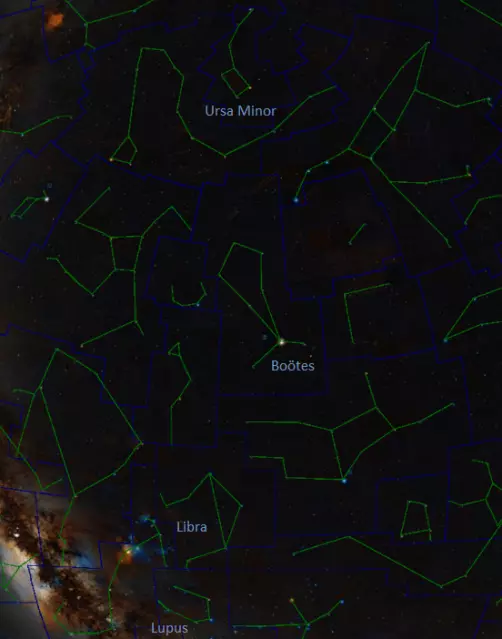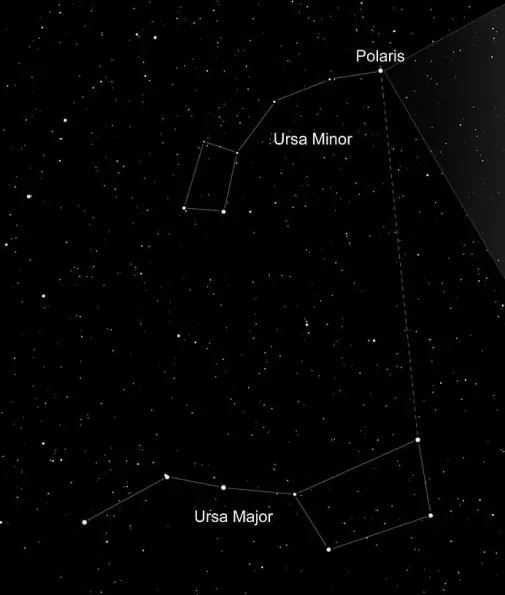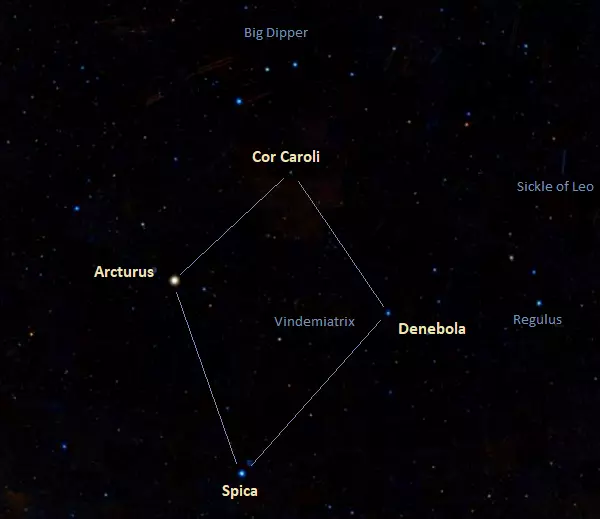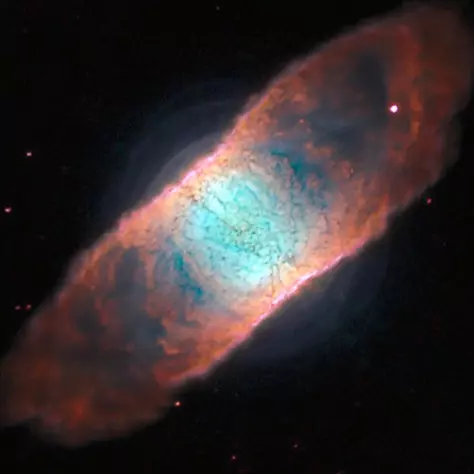The constellations best seen in June are Boötes, Libra, Lupus and Ursa Minor. Boötes and Ursa Minor lie in the northern sky, while Libra and Lupus are located south of the celestial equator.
Ursa Minor, the Little Bear, occupies an area of 256 degrees and its brightest stars form one of the best known asterisms in the northern sky, the Little Dipper. Ursa Minor is invisible to observers in the southern hemisphere (except for those living north of latitude 10°S), but it is circumpolar, i.e. it never sets below the horizon for observers north of the equator.
The Little Dipper is used in navigation because the star that marks the end of the Dipper’s handle or the tip of the Bear’s tail is Polaris, the North Star, the closest bright star to the north celestial pole.

June constellations, image: Wikisky
Polaris, Alpha Ursae Minoris, is a triple star system composed of a yellow supergiant and two smaller companions. It is the brightest Cepheid variable in the sky. (Cepheids are stars that pulsate radially, varying in size and temperature, which results in changes in brightness over a certain period of time.)

Location of Polaris and the Little Dipper, image: Hubblesite. Credit: NASA, ESA, N. Evans (Harvard-Smithsonian CfA), and H. Bond (STScI)
However, with an apparent magnitude varying between 1.86 and 2.13, Polaris is only the 48th brightest star in the sky and it is not particularly conspicuous. The other stars of the Little Dipper are even fainter, which makes it difficult to find Polaris without using the Pointer Stars, Merak and Dubhe, in the brighter and larger Big Dipper.
Kochab (Beta UMi) and Pherkad (Gamma UMi), the second and third brightest star in Ursa Minor, are known as the “guardians of the pole star.” Kochab is only slightly fainter than Polaris, with a visual magnitude of 2.07, while Pherkad is a full magnitude fainter (mag. 3.04).
Ursa Minor does not have many notable deep sky objects. The Ursa Minor Dwarf, a dwarf spheroidal galaxy with a visual magnitude of 11.9, is a satellite of the Milky Way and contains mostly old stars. The barred spiral galaxy NGC 6217, located near Zeta Ursae Minoris, is a starburst galaxy with an apparent magnitude of 11.2 that can be observed in a 4-inch or larger telescope. The active supergiant elliptical radio galaxy NGC 6251 has one of the brightest radio jets ever discovered. It lies at a distance of 340 million light years and has a visual magnitude of 14.3.
Occupying an area of 907 square degrees, Boötes is the 13th largest constellation in the sky. With an apparent magnitude of -0.05, its brightest star, Arcturus, is the fourth (third individual) brightest star in the sky and the brightest star in the northern sky, just ahead of Vega in Lyra and Capella in Auriga.

The Great Diamond, image: Wikisky
Arcturus is part of two prominent spring asterisms. It forms the Spring Triangle with the stars Spica in Virgo and Regulus (or Denebola) in Leo and the Great Diamond of Virgo with Spica, Denebola and Cor Caroli in Canes Venatici.
Arcturus is an orange giant located at a distance of only 36.7 light years from Earth. The star marks the left foot of Boötes, the Herdsman, and its name comes from the Ancient Greek Ἀρκτοῦρος, meaning Guardian of the Bear, referring to Ursa Major. The stars of Ursa Major can be used to find Arcturus, as the handle of the Big Dipper points toward the star.
The multiple stars Izar, Epsilon Boötis, and Alkalurops, Mu Boötis, are particularly popular with stargazers. Izar is a colourful binary system that consists of an orange giant and a white main sequence star, while Alkalurops is a multiple star composed of a pair of double stars.
Arcturus, Izar and several other bright stars in the constellation form a large asterism known as the Kite, which dominates the evening sky along with the considerably brighter Big Dipper in the spring months.
Boötes does not contain many bright deep sky objects. The globular cluster NGC 5466 has an apparent magnitude of 10.5 and forms a roughly equilateral triangle with the stars Izar and Arcturus. The brighter galaxies in the constellation include NGC 5248, a compact intermediate spiral with an apparent magnitude of 10.97, and NGC 5676, an unbarred spiral galaxy with a visual magnitude of 12.3. The Boötes Dwarf Galaxy, a dwarf spheroidal galaxy 197 thousand light years away, appears slightly fainter, with a magnitude of 13.1. With an absolute magnitude of -5.8, it is one of the faintest galaxies ever discovered.
The constellation is also home to the Boötes void, a vast space empty of galaxies, stretching across 250 million light years.
To the south, the constellation Libra is fairly large, occupying 538 square degrees, but it is not particularly bright, with no 1st magnitude stars. The brightest star in the constellation, Zubeneschamali (Beta Librae), has an apparent magnitude of 2.61. Zubenelgenubi (Alpha Librae), the second brightest star, is only slightly fainter, with a visual magnitude of 2.75. The two stars represent the scales’ balance beam and form a quadrangle with the fainter Zubenelhakrabi (Gamma Librae) and Brachium (Sigma Librae), which represent the weighing pans.
The stars’ names reflect the fact that they were once considered to be part of Scorpius constellation: Zubeneschamali comes from the Arabic phrase meaning “the Northern Claw,” Zubenelgenubi means “the Southern Claw,” and Zubenelakrab means “the scorpion’s claw.” Brachium was known as Gamma Scorpii before it was designated as Sigma Librae in the mid-19th century.
Libra does not contain many bright deep sky objects. The notable ones include the globular cluster NGC 5897 with an apparent magnitude of 8.52, the barred spiral galaxies NGC 5792 (mag. 12.1) and NGC 5885 (mag. 11.8), and the unbarred lenticular galaxy NGC 5890 (mag. 14).
The neighbouring Lupus, the Wolf, is located between the more prominent constellations Scorpius and Centaurus. It is invisible to observers north of latitude 35°N. The constellation contains 127 stars brighter than or equal to magnitude 6.5, but its brightest stars are not particularly prominent. Alpha Lupi, a blue giant star classified as a Beta Cephei variable, has a visual magnitude of 2.30. Located at a distance of 460 light years from Earth, it is one of the nearest supernova candidates, after IK Pegasi (154.4 light years) and Spica (250 light years).
Lupus contains several interesting deep sky objects. These include the bright globular clusters NGC 5927 (mag. 8.86), NGC 5824 (mag. 9.09) and NGC 5986 (mag. 8.0), the planetary nebulae NGC 5882 and IC 4406, also known as the Retina Nebula, the open clusters NGC 5822 (mag. 10.28) and NGC 5749 (mag. 11.23), and SN 1006, the remnant of the historic supernova observed in 1006. SN 1006 was the brightest supernova ever recorded. It reached an estimated apparent magnitude of -7.5 and was even visible in the daytime according to some sources.

The coupling of the AOF with MUSE gives access to both greater sharpness and a wide dynamic range when observing celestial objects like planetary nebulae. These new observations of IC 4406 revealed shells that have never been seen before, along with the already familiar dark dust structures in the nebula that gave it the popular name the Retina Nebula. This image shows a small fraction of the total data collected by the MUSE using the AOF system and demonstrates the increased abilities of the new AOF equipped MUSE instrument. Image: ESO/J. Richard (CRAL)
The table below shows the latitudes between which the June constellations are visible.
| Constellation | Northern latitude | Southern latitude |
| Boötes | 90° | 50° |
| Libra | 65° | 90° |
| Lupus | 35° | 90° |
| Ursa Minor | 90° | 10° |